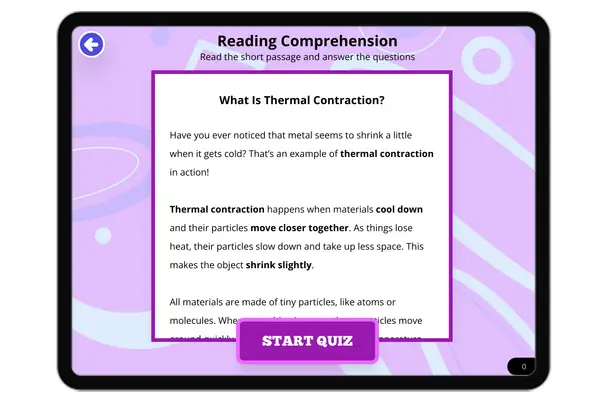What Is an Endothermic Reaction? — Passage
Have you ever used an instant cold pack for a sore ankle? When you squeeze it, the pack suddenly gets cold. That’s because of something called an endothermic reaction.
An endothermic reaction is a chemical reaction that absorbs heat from its surroundings. This means the reaction needs energy—usually in the form of heat—to happen. Instead of giving off heat, like a fire does, an endothermic reaction takes in heat, causing the area around it to feel cooler.
One easy example is photosynthesis, the process plants use to make food. Plants absorb sunlight (a form of energy) and use it to turn carbon dioxide and water into sugar and oxygen. This is an endothermic reaction because it needs energy to take place.
Another example is mixing baking soda and vinegar. While this reaction doesn’t get very cold, it still absorbs some energy. You can also see endothermic reactions in action when certain salts dissolve in water and make the water feel cold.
Endothermic reactions are the opposite of exothermic reactions, which release heat. For example, burning wood or fireworks give off heat and light—that’s an exothermic reaction.
Scientists and engineers use endothermic reactions in many ways, like cooling systems, instant cold packs, and even in space missions where temperature control is important.
So, next time you feel something getting cooler during a chemical change, you might be watching an endothermic reaction at work!
Fun Fact: Some instant cold packs used by athletes work because of an endothermic reaction between water and ammonium nitrate—when mixed, they absorb so much heat that the pack gets cold in just seconds without needing a freezer!
What is an endothermic reaction?
A reaction that produces lightA reaction that releases heatA reaction that absorbs heat from its surroundingsA reaction that stays at room temperatureWhat happens to the area around an endothermic reaction?
It gets warmerIt changes colorIt feels coolerIt turns into gasWhich of the following is an example of an endothermic reaction?
Fireworks explodingA candle burningPhotosynthesis in plantsIce melting in the sunWhat kind of energy does photosynthesis absorb?
Heat energy from the soilChemical energy from waterLight energy from the sunSound energy from the airWhich item uses an endothermic reaction to help injuries?
A heating padA hot water bottleAn instant cold packA flashlightWhat is the opposite of an endothermic reaction?
Reversible reactionPhysical changeExothermic reactionThermal reactionWhat do endothermic and exothermic reactions both involve?
Changing soundMoving waterTransferring energyFreezing liquidsWhy is photosynthesis important as an endothermic reaction?
It releases lightIt creates sugar for plantsIt produces fireIt makes animals grow










